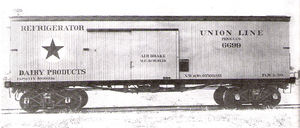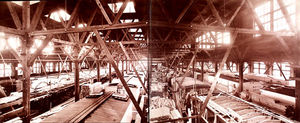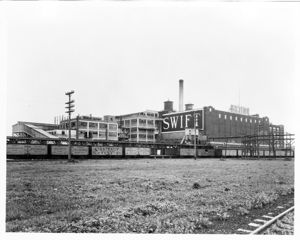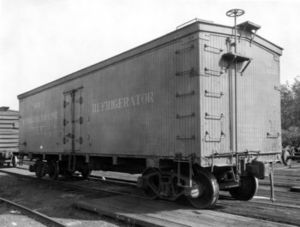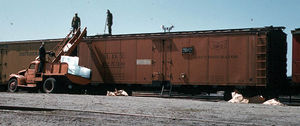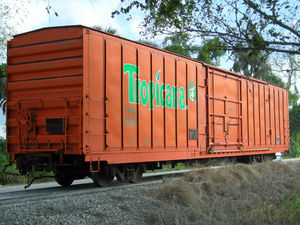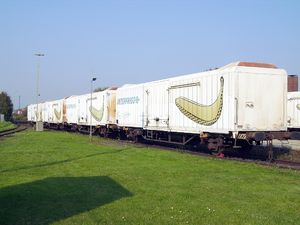Refrigerator car/Gallery: Difference between revisions
Jump to navigation
Jump to search

imported>Robert A. Estremo (add images) |
imported>Robert A. Estremo m (reposition images) |
||
| (2 intermediate revisions by the same user not shown) | |||
| Line 2: | Line 2: | ||
<gallery perrow=3 widths=300px heights=250px> | <gallery perrow=3 widths=300px heights=250px> | ||
Image:Union Refrigerator Line 6699.jpg|{{Union Refrigerator Line 6699.jpg/credit}}<br />Union Refrigerator Line refrigerator car #6699, used to transport milk, cheese, and eggs. | Image:Union Refrigerator Line 6699.jpg|{{Union Refrigerator Line 6699.jpg/credit}}<br />Union Refrigerator Line refrigerator car #6699, used to transport milk, cheese, and eggs. | ||
Image:MDT East Rochester car shops ''circa'' 1905.jpg|{{MDT East Rochester car shops ''circa'' 1905.jpg/credit}}<br />Rows of reefers in various stages of construction fill MDT's car shop, ''circa'' 1905. | Image:MDT East Rochester car shops ''circa'' 1905.jpg|{{MDT East Rochester car shops ''circa'' 1905.jpg/credit}}<br />Rows of reefers in various stages of construction fill MDT's car shop, ''circa'' 1905. | ||
Image:Interior of ice bunker reefer.jpg|{{Interior of ice bunker reefer.jpg/credit}}<br />The interior of a typical ice-bunker reefer from the 1920s; the wood sheathing would give way to plywood within twenty years. Vents in the bunker at the end of the car, along with slots in the wood floor racks, allowed cool air to circulate around the contents during transit. | |||
Image:Interior of ice bunker reefer.jpg|{{Interior of ice bunker reefer.jpg/credit}}<br /> | |||
Image:Swift Brands Sioux City, Iowa meat packing plant.jpg|{{Swift Brands Sioux City, Iowa meat packing plant.jpg/credit}}<br />A view of the Swift Brands [[Sioux City, Iowa]] meat packing plant, ''circa'' 1917. All but one of the refrigerator cars in the photo bear the markings of the Swift Refrigerator Line. | Image:Swift Brands Sioux City, Iowa meat packing plant.jpg|{{Swift Brands Sioux City, Iowa meat packing plant.jpg/credit}}<br />A view of the Swift Brands [[Sioux City, Iowa]] meat packing plant, ''circa'' 1917. All but one of the refrigerator cars in the photo bear the markings of the Swift Refrigerator Line. | ||
Image:Swift reefer East Orange NJ late 1930s.jpg|{{Swift reefer East Orange NJ late 1930s.jpg/credit}}<br />A Swift refrigerator car has reached the end-of-the-line at [[East Orange, New Jersey]]. The car has been repainted and was photographed in mid- or late-1937, after the use of "billboard" advertising on [[freight car]]s had been banned by the [[Interstate Commerce Commission]], and such cars could no longer be accepted for interchange between roads. | Image:Swift reefer East Orange NJ late 1930s.jpg|{{Swift reefer East Orange NJ late 1930s.jpg/credit}}<br />A Swift refrigerator car has reached the end-of-the-line at [[East Orange, New Jersey]]. The car has been repainted and was photographed in mid- or late-1937, after the use of "billboard" advertising on [[freight car]]s had been banned by the [[Interstate Commerce Commission]], and such cars could no longer be accepted for interchange between roads. | ||
Image:American Refrigerator Transit Co 1940.jpg|{{American Refrigerator Transit Co 1940.jpg/credit}}<br />A wood-sided refrigerator car of the American Refrigerator Transit Company specially-designated for dairy products, ''circa'' 1940. | Image:American Refrigerator Transit Co 1940.jpg|{{American Refrigerator Transit Co 1940.jpg/credit}}<br />A wood-sided refrigerator car of the American Refrigerator Transit Company specially-designated for dairy products, ''circa'' 1940. | ||
Image: | Image:MDT-GMO 12530.jpg|{{MDT-GMO 12530.jpg/credit}}<br />An early version of a field icing car loads a Merchants Despatch Transportation Co. reefer (bearing the herald of the GM&O) in Norfolk, Virginia in April 1955. | ||
Image:TPIX 250.jpg|{{TPIX 250.jpg/credit}}<br />Tropicana refrigerated box car #250. | Image:TPIX 250.jpg|{{TPIX 250.jpg/credit}}<br />Tropicana refrigerated box car #250. | ||
Image:Kuehlwagen Interfrigo.jpg|{{Kuehlwagen Interfrigo.jpg/credit}}<br />Interfrigo's refrigerated vans are designed for the transportation of bananas. | |||
Image:Kuehlwagen Interfrigo.jpg|{{Kuehlwagen Interfrigo.jpg/credit}}<br /> | |||
</gallery> | </gallery> | ||
Latest revision as of 23:08, 14 August 2013
(PD) Photo: Swift Brands
A view of the Swift Brands Sioux City, Iowa meat packing plant, circa 1917. All but one of the refrigerator cars in the photo bear the markings of the Swift Refrigerator Line.(PD) Photo: William B. Barry
A Swift refrigerator car has reached the end-of-the-line at East Orange, New Jersey. The car has been repainted and was photographed in mid- or late-1937, after the use of "billboard" advertising on freight cars had been banned by the Interstate Commerce Commission, and such cars could no longer be accepted for interchange between roads.
